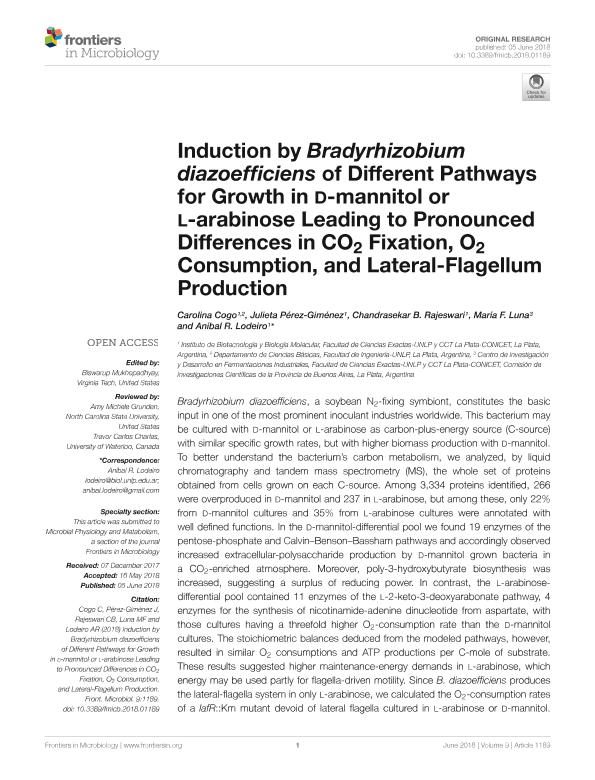Mostrar el registro sencillo del ítem
dc.contributor.author
Cogo, Carolina

dc.contributor.author
Pérez Giménez, Julieta

dc.contributor.author
Rajeswari, Chandrasekar B.
dc.contributor.author
Luna, Maria Flavia

dc.contributor.author
Lodeiro, Anibal

dc.date.available
2020-02-07T21:40:16Z
dc.date.issued
2018-06
dc.identifier.citation
Cogo, Carolina; Pérez Giménez, Julieta; Rajeswari, Chandrasekar B.; Luna, Maria Flavia; Lodeiro, Anibal; Induction by Bradyrhizobium diazoefficiens of different pathways for growth in D-mannitol or L-arabinose leading to pronounced differences in CO2 Fixation, O2 consumption, and lateral-flagellum production; Frontiers Research Foundation; Frontiers in Microbiology; 9; JUN; 6-2018; 1-16
dc.identifier.issn
1664-302X
dc.identifier.uri
http://hdl.handle.net/11336/96974
dc.description.abstract
Bradyrhizobium diazoefficiens, a soybean N2-fixing symbiont, constitutes the basic input in one of the most prominent inoculant industries worldwide. This bacterium may be cultured with D-mannitol or L-arabinose as carbon-plus-energy source (C-source) with similar specific growth rates, but with higher biomass production with D-mannitol. To better understand the bacterium's carbon metabolism, we analyzed, by liquid chromatography and tandem mass spectrometry (MS), the whole set of proteins obtained from cells grown on each C-source. Among 3,334 proteins identified, 266 were overproduced in D-mannitol and 237 in L-arabinose, but among these, only 22% from D-mannitol cultures and 35% from L-arabinose cultures were annotated with well defined functions. In the D-mannitol-differential pool we found 19 enzymes of the pentose-phosphate and Calvin-Benson-Bassham pathways and accordingly observed increased extracellular-polysaccharide production by D-mannitol grown bacteria in a CO2-enriched atmosphere. Moreover, poly-3-hydroxybutyrate biosynthesis was increased, suggesting a surplus of reducing power. In contrast, the L-arabinose-differential pool contained 11 enzymes of the L-2-keto-3-deoxyarabonate pathway, 4 enzymes for the synthesis of nicotinamide-adenine dinucleotide from aspartate, with those cultures having a threefold higher O2-consumption rate than the D-mannitol cultures. The stoichiometric balances deduced from the modeled pathways, however, resulted in similar O2 consumptions and ATP productions per C-mole of substrate. These results suggested higher maintenance-energy demands in L-arabinose, which energy may be used partly for flagella-driven motility. Since B. diazoefficiens produces the lateral-flagella system in only L-arabinose, we calculated the O2-consumption rates of a lafR::Km mutant devoid of lateral flagella cultured in L-arabinose or D-mannitol. Contrary to that of the wild-type, the O2-consumption rate of this mutant was similar on both C-sources, and accordingly outcompeted the wild-type in coculture, suggesting that the lateral flagella behaved as parasitic structures under these conditions. Proteomic data are available via ProteomeXchange with identifier PXD008263.
dc.format
application/pdf
dc.language.iso
eng
dc.publisher
Frontiers Research Foundation

dc.rights
info:eu-repo/semantics/openAccess
dc.rights.uri
https://creativecommons.org/licenses/by-nc-sa/2.5/ar/
dc.subject
BRADYRHIZOBIUM
dc.subject
CBB PATHWAY
dc.subject
FLAGELLA
dc.subject
L-KDA PATHWAY
dc.subject
O2 CONSUMPTION
dc.subject
PP PATHWAY
dc.subject.classification
Biología Celular, Microbiología

dc.subject.classification
Ciencias Biológicas

dc.subject.classification
CIENCIAS NATURALES Y EXACTAS

dc.title
Induction by Bradyrhizobium diazoefficiens of different pathways for growth in D-mannitol or L-arabinose leading to pronounced differences in CO2 Fixation, O2 consumption, and lateral-flagellum production
dc.type
info:eu-repo/semantics/article
dc.type
info:ar-repo/semantics/artículo
dc.type
info:eu-repo/semantics/publishedVersion
dc.date.updated
2019-10-04T13:41:18Z
dc.journal.volume
9
dc.journal.number
JUN
dc.journal.pagination
1-16
dc.journal.pais
Suiza

dc.description.fil
Fil: Cogo, Carolina. Consejo Nacional de Investigaciones Científicas y Técnicas. Centro Científico Tecnológico Conicet - La Plata. Instituto de Biotecnología y Biología Molecular. Universidad Nacional de La Plata. Facultad de Ciencias Exactas. Instituto de Biotecnología y Biología Molecular; Argentina
dc.description.fil
Fil: Julieta Pérez-Giménez. Consejo Nacional de Investigaciones Científicas y Técnicas. Centro Científico Tecnológico Conicet - La Plata. Instituto de Biotecnología y Biología Molecular. Universidad Nacional de La Plata. Facultad de Ciencias Exactas. Instituto de Biotecnología y Biología Molecular; Argentina
dc.description.fil
Fil: Chandrasekar B. Rajeswari. Consejo Nacional de Investigaciones Científicas y Técnicas. Centro Científico Tecnológico Conicet - La Plata. Instituto de Biotecnología y Biología Molecular. Universidad Nacional de La Plata. Facultad de Ciencias Exactas. Instituto de Biotecnología y Biología Molecular; Argentina
dc.description.fil
Fil: María F. Luna. Consejo Nacional de Investigaciones Científicas y Técnicas. Centro Científico Tecnológico Conicet - La Plata. Centro de Investigación y Desarrollo en Fermentaciones Industriales. Universidad Nacional de La Plata. Facultad de Ciencias Exactas. Centro de Investigación y Desarrollo en Fermentaciones Industriales; Argentina
dc.description.fil
Fil: Aníbal R. Lodeiro. Consejo Nacional de Investigaciones Científicas y Técnicas. Centro Científico Tecnológico Conicet - La Plata. Instituto de Biotecnología y Biología Molecular. Universidad Nacional de La Plata. Facultad de Ciencias Exactas. Instituto de Biotecnología y Biología Molecular; Argentina
dc.journal.title
Frontiers in Microbiology
dc.relation.alternativeid
info:eu-repo/semantics/altIdentifier/doi/http://dx.doi.org/10.3389/fmicb.2018.01189
dc.relation.alternativeid
info:eu-repo/semantics/altIdentifier/url/https://www.frontiersin.org/articles/10.3389/fmicb.2018.01189/full
dc.relation.alternativeid
info:eu-repo/semantics/altIdentifier/url/https://www.ncbi.nlm.nih.gov/pmc/articles/PMC5996035/
Archivos asociados
